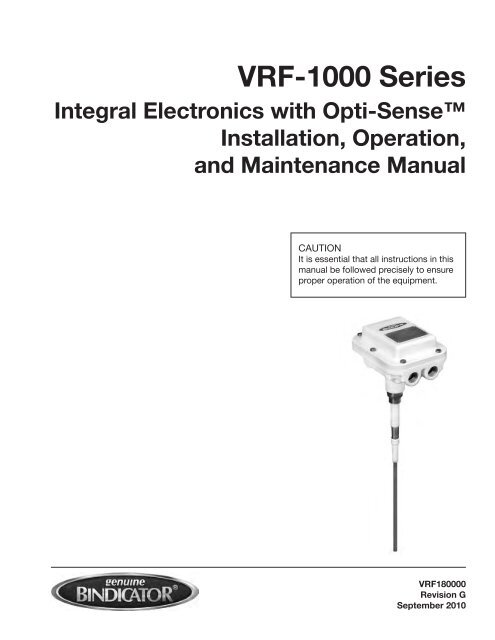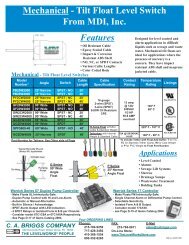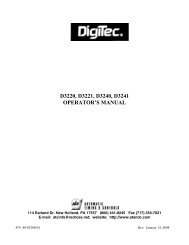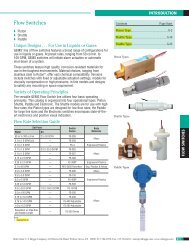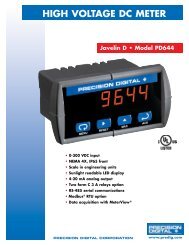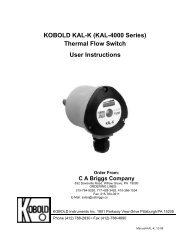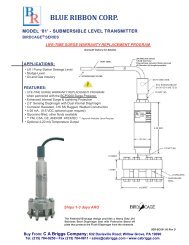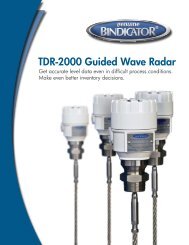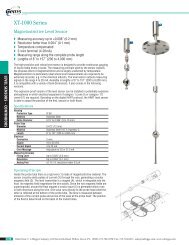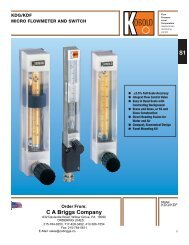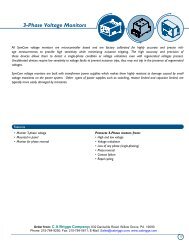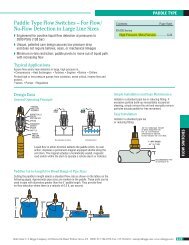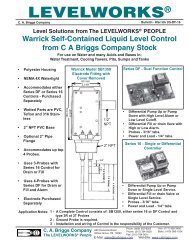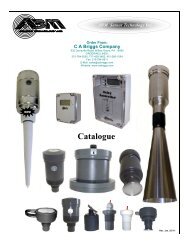VRF-1000 Series Integral Electronics with Opti-Sense ... - Bindicator
VRF-1000 Series Integral Electronics with Opti-Sense ... - Bindicator
VRF-1000 Series Integral Electronics with Opti-Sense ... - Bindicator
Create successful ePaper yourself
Turn your PDF publications into a flip-book with our unique Google optimized e-Paper software.
<strong>VRF</strong>-<strong>1000</strong> <strong>Series</strong><br />
<strong>Integral</strong> <strong>Electronics</strong> <strong>with</strong> <strong>Opti</strong>-<strong>Sense</strong><br />
Installation, Operation,<br />
and Maintenance Manual<br />
CAUTION<br />
It is essential that all instructions in this<br />
manual be followed precisely to ensure<br />
proper operation of the equipment.<br />
<strong>VRF</strong>180000<br />
Revision G<br />
September 2010
SAFETY INFORMATION<br />
Before installing the <strong>VRF</strong>-<strong>1000</strong>, please read these instructions and be completely familiar <strong>with</strong> the<br />
requirements and functions of the sensor.<br />
The <strong>VRF</strong>-<strong>1000</strong> sensor must only be installed and operated as described in this instruction manual. Note<br />
that other actions can cause damage for which <strong>Bindicator</strong> ® does not take responsibility. If the model is<br />
not installed correctly or used in unapproved applications, dangers may arise such as product overflow.<br />
Ensure that all personnel installing, wiring, and calibrating this device are suitably qualified. All wiring<br />
must conform to current National Electrical Code (NEC) requirements or local electrical codes. Please<br />
be aware that any modification of the equipment may cause injury or death.<br />
If any questions or problems arise during the installation of this equipment, please contact the<br />
<strong>Bindicator</strong> ® Applications Department at (800) 778.9242 or (864) 574.8960.
TABLE OF CONTENTS<br />
CHAPTER 1. PRODUCT DESCRIPTION................................................................................................. 1<br />
Function...................................................................................................................................................... 1<br />
Applications................................................................................................................................................ 1<br />
Model Code Identification........................................................................................................................... 2<br />
Technical Specifications/Approvals............................................................................................................ 3<br />
Dimensions................................................................................................................................................. 3<br />
CHAPTER 2. HANDLING AND STORAGE.............................................................................................. 4<br />
Inspection and Handling............................................................................................................................. 4<br />
Storage....................................................................................................................................................... 4<br />
CHAPTER 3. MECHANICAL INSTALLATION.......................................................................................... 5<br />
Guidelines................................................................................................................................................... 5<br />
Mounting..................................................................................................................................................... 5<br />
CHAPTER 4. ELECTRICAL INSTALLATION............................................................................................ 6<br />
Guidelines................................................................................................................................................... 6<br />
Conduit-Cable Connection................................................................................................................... 6<br />
Input Power........................................................................................................................................... 6<br />
Connection Information........................................................................................................................ 6<br />
Connection Information/Wiring Diagram.................................................................................................... 6<br />
CHAPTER 5. SET-UP AND CALIBRATION.............................................................................................. 8<br />
Operation.................................................................................................................................................... 8<br />
Settings and Adjustments............................................................................................................................ 8<br />
Fail-Safe Selection....................................................................................................................................... 8<br />
High Level Fail-Safe Operation.............................................................................................................. 8<br />
Low Level Fail-Safe Operation............................................................................................................... 8<br />
Sensitivity Setting................................................................................................................................... 8<br />
Time Delay Setting................................................................................................................................. 8<br />
Enable Automatic Calibration Feature................................................................................................... 9<br />
CHAPTER 6. START-UP AND OPERATION........................................................................................... 10<br />
CHAPTER 7. MAINTENANCE AND SPARE PARTS LIST..................................................................... 11<br />
CHAPTER 8. TROUBLESHOOTING...................................................................................................... 12<br />
APPENDIX................................................................................................................................................ 13
CHAPTER 1. PRODUCT DESCRIPTION<br />
FUNCTION<br />
The <strong>VRF</strong>-<strong>1000</strong> is a line powered (AC or DC) material level sensor that outputs a DPDT relay contact.<br />
The electronics and probe are integral. It is a point level sensor used to detect the presence or absence<br />
of material at a point inside a tank, bin, or other vessel. Material coming in contact <strong>with</strong> the unit’s probe<br />
causes its output relay to change state, thereby indicating to the user the presence of material.<br />
Operation of the <strong>VRF</strong>-<strong>1000</strong> is based upon the <strong>Bindicator</strong> ® <strong>Opti</strong>-<strong>Sense</strong> technology using Variable Radio<br />
Frequency (<strong>VRF</strong>) which automatically selects the optimal operating frequency (20kHz to 100kHz) of<br />
the low voltage signal applied to the probe, depending on the probe circuit impedance.<br />
A dual core microprocessor scans the probe circuit and digitally analyzed voltage and current values to<br />
characterize the complex impedance seen by the probe. The digital signal processor continuously<br />
analyzed the conductance and susceptance of the probe circuit and calculates when to alarm the unit.<br />
APPLICATIONS<br />
This model is ideal for the point level detection of granulars, powders, liquids, and slurries. In addition, it<br />
is effective in the measurement of materials <strong>with</strong> a dielectric constant as low as 1.2.<br />
1
MODEL CODE IDENTIFICATION<br />
Note 1: For 3A Sanitary Certification, add “3A”at the end of the model code. Assembly S must be<br />
used and either Probe Type 2 (Food Grade Polysulfone) or Probe Type 4 (Stub Polysulfone)<br />
must be used.<br />
Note 2: Thickness of probe must be specified: 3/8 in., 1/2 in., 5/8 in., or 3/4 in. wall thickness.<br />
Note 1: Maximum length is 45 ft. (13.72m) = 540 in. (1,371.6cm).<br />
2
TECHNICAL SPECIFICATIONS/APPROVALS<br />
ELECTRONICS<br />
Line Voltage<br />
Power Consumption<br />
Output Relay<br />
AC Models 85VAC to 265VAC; DC Models 10VDC to 36VDC<br />
5.5 watts maximum<br />
2 form C (DPDT), 6A at 240VAC, 6A at 30VDC, minimum load<br />
12V/100mA<br />
Temperature Range -40° F to +158° F (-40° C to +70° C)<br />
Sensitivity Settings See Chapter 5<br />
Selectable Time Delay See Chapter 5<br />
PROBES<br />
Standard Duty 316 Stainless Steel and Ryton ® , 150 PSI (10.5kg/cm 2 )<br />
-100° F to +450° F (-73° C to +232° C)<br />
Standard Kynar ® Coated 316 Stainless Steel and Ryton ® coated <strong>with</strong> Kynar ® , 50 PSI (3.5kg/cm 2 )<br />
-100° F to +250° F (-73° C to +121° C)<br />
Food Grade 316 Stainless Steel and Polysulfone, 150 PSI (10.5kg/cm 2 )<br />
-30° F to +300° F (-34° C to +149° C)<br />
Stub 316 Stainless Steel and Polysulfone, 150 PSI (10.5kg/cm 2 )<br />
-30° F to +300° F (-34° C to +149° C)<br />
Heavy Duty 316 Stainless Steel and Ryton ® , 150 PSI (10.5kg/cm 2 )<br />
-100° F to +450° F (-73° C to + 232° C)<br />
Heavy Duty Kynar ® Coated 316 Stainless Steel and Ryton ® coated <strong>with</strong> Kynar ® , 50 PSI (3.5kg/cm 2 )<br />
-100° F to +250° F (-73° C to +121° C)<br />
Flush and Dome Flush 316 Stainless Steel and Epoxy, 50 PSI (3.5kg/cm 2 )<br />
-30° F to +200° F (-34° C to +93° C)<br />
Armored Food Grade 316 Stainless Steel and Food Grade Epoxy, 150 PSI (10.5kg/cm 2 )<br />
-30° F to +230° F (-34° C to +110° C)<br />
Jumbo 316 Stainless Steel and Epoxy, 50 PSI (3.5kg/cm 2 )<br />
-30° F to +200° F (-34° C to +93° C)<br />
Teflon ® Jacketed 316 Stainless Steel and FEP Teflon ® , 50 PSI (3.5kg/cm 2 )<br />
-30° F to +250° F (-34° C to +121° C)<br />
Teflon ® Jacketed Heavy Duty 316 Stainless Steel and FEP Teflon ® , 50 PSI (3.5kg/cm 2 )<br />
-30° F to +250° F (-34° C to +121° C)<br />
Fly Ash 316 Stainless Steel and Ryton ® coated <strong>with</strong> Kynar ® , 50 PSI (3.5kg/cm 2 )<br />
-100° F to +250° F (-73° C to +121° C)<br />
APPROVALS<br />
FM Approved Electrical measurement equipment for use in indoor/outdoor (NEMA 4X,<br />
IP66) unclassified locations.<br />
DIMENSIONS<br />
See the Appendix for appropriate model drawings and applicable housing and probe dimensions.<br />
3
CHAPTER 2. HANDLING AND STORAGE<br />
INSPECTION AND HANDLING<br />
The <strong>VRF</strong>-<strong>1000</strong> is individually packed to provide adequate protection during shipping and has been<br />
tested and calibrated at the manufacturing facility. When the unit is received, it should be inspected for<br />
damage that may have occurred due to mishandling during shipping. If the unit is received damaged,<br />
DO NOT dispose of the carton or packing materials. Notify the shipping carrier immediately. If any<br />
problems arise, please contact <strong>Bindicator</strong> ® at (800) 778.9242 or (864) 574.8060.<br />
STORAGE<br />
After receiving the <strong>VRF</strong>-<strong>1000</strong>, care should be taken to avoid damage. If the unit is not scheduled to be<br />
installed immediately after delivery, the following steps should be taken:<br />
1. After inspection, repackage the unit into its original packaging.<br />
2. Select a clean, dry site for storage. Location should be free of vibration, shock, and impact hazards.<br />
If the <strong>VRF</strong> point level unit will be in storage for more than 30 days, it must be stored in a<br />
non-condensing atmosphere <strong>with</strong> less than 100% relative humidity.<br />
DO NOT STORE THE UNPOWERED UNIT OUTDOORS FOR A PROLONGED PERIOD.<br />
4
GUIDELINES<br />
CHAPTER 3. MECHANICAL INSTALLATION<br />
The probe can be mounted on the side of the vessel horizontally, or on the top of the vessel vertically.<br />
The probe should be located out of the direct flow of material into the vessel.<br />
MOUNTING<br />
Consult the appropriate dimensional drawing in the Appendix for mounting information related to the<br />
model ordered.<br />
5
GUIDELINES<br />
CHAPTER 4. ELECTRICAL INSTALLATION<br />
The <strong>VRF</strong> unit is a line powered point level switch <strong>with</strong> a DPDT isolated relay contact output. Wiring<br />
will consist of:<br />
Grounding<br />
Input supply line power<br />
Output relay contacts for signal/control<br />
CONDUIT-CABLE CONNECTION<br />
Two threaded 0.75 in. NPT female conduit openings are provided in the housing for input and output<br />
wiring. When only one conduit opening is used for installation, the unused opening must be sealed<br />
<strong>with</strong> a suitable Type 4X/IP66 0.75 in. - 14 NPT plug <strong>with</strong> pipe sealant in order to maintain approval<br />
requirements.<br />
INPUT POWER<br />
The <strong>VRF</strong> unit is either an AC or DC input model. Consult the model codes in Chapter 1 and the<br />
nameplate of the unit to determine the proper power supply.<br />
CONNECTION INFORMATION<br />
See Figures 4.1 and 4.2 for location of input and output wiring.<br />
WARNING!<br />
Either AC or DC power is to be connected to the power input depending on the model. Consult the<br />
nameplate of the unit and Chapter 1 to determine what type of power is required. Consult Chapter 1 for<br />
the allowable voltage ranges.<br />
CONNECTION INFORMATION/WIRING DIAGRAM<br />
See Figure 4.1 for location of input and output terminal blocks. Agency approved insulated barrel type<br />
terminals are supplied in the input terminal block to provide additional safety. These terminals must be<br />
used in order to maintain approval requirements. See Figure 4.2 for output contact positions during<br />
stages of operation.<br />
WARNING!<br />
An electrical earth ground connection must be made to the housing input ground screw located inside<br />
the enclosure. See Figure 4.1 for location. This connection is needed for both electrical safety and<br />
proper operation of the unit. This is required for both AC and DC units.<br />
WARNING!<br />
The external ground wire (included) MUST be attached to the wall or the top of the metal vessel in order<br />
to provide the proper reference to the probe.<br />
6
DIP Switch SW1<br />
Up Position = ON<br />
Calibration<br />
Indication LED<br />
GREEN<br />
Material<br />
Sensing LED<br />
RED<br />
Recalibration<br />
Button<br />
Power Indicator<br />
LED 3.3<br />
Power Indicator<br />
LED 5.0<br />
Power Indicator<br />
LED 6.0<br />
Relay Status<br />
LED<br />
Input<br />
L1 Hot (AC Model)<br />
(+) (DC Model)<br />
1A Fuse<br />
Input<br />
L2 Neutral (AC Model)<br />
(-) (DC Model)<br />
NO1 C1 NC1 NO2 C2 NC2<br />
Output Relay Connections<br />
Figure 4.1 - <strong>VRF</strong>-<strong>1000</strong> <strong>Electronics</strong>.<br />
Figure 4.2 - High/Low Level Fail-Safe.<br />
The output relay contacts are labeled in the un-powered alarm state. The relay is energized when the<br />
<strong>VRF</strong>-<strong>1000</strong> is not alarmed. This status may be opposite that of other <strong>Bindicator</strong> ® brand units. If the<br />
<strong>VRF</strong>-<strong>1000</strong> is replacing an older Model RF-8000 or RF-9000 <strong>Series</strong> unit, connections will need to be<br />
opposite. If a connection was made to the NC1 terminal of the RF-8000 or RF-9000 <strong>Series</strong> unit,<br />
connect now to the NO1 terminal of the <strong>VRF</strong>-<strong>1000</strong>. C1 and C2 connections remain the same.<br />
7
OPERATION<br />
CHAPTER 5. SET-UP AND CALIBRATION<br />
The <strong>VRF</strong> unit will begin operating when powered up. The sensitivity, fail-safe, and time delay settings<br />
can be made <strong>with</strong>out power applied. Recalibration will require that the unit be powered. Changes to<br />
the sensitivity, fail-safe, and time delay do not require a recalibration.<br />
SETTINGS AND ADJUSTMENTS<br />
FAIL-SAFE SELECTION<br />
The <strong>VRF</strong> is shipped from the manufacturing facility in the high level fail-safe condition. This setting is<br />
made on DIP switch SW1, position 5. See Figure 4.1 in Chapter 4.<br />
HIGH LEVEL FAIL-SAFE OPERATION<br />
DIP Switch SW1 position 5 is ON.<br />
If the electrical power fails, the relay turns OFF. This indicates material as if the tank is full.<br />
Relay status LED is ON when no material is present, and OFF when material is present.<br />
Alarm LED (red) is OFF when no material is present, and ON when material is present.<br />
Relay NC output contacts are open when no material is present and closed when material is present.<br />
NO output contacts are closed when no material is present and open when material is present.<br />
LOW LEVEL FAIL-SAFE OPERATION<br />
DIP Switch SW1 position 5 is OFF.<br />
Relay status LED is OFF when no material is present, and ON when material is present.<br />
Alarm LED (red) is OFF when no material is present, and ON when material is present.<br />
Relay NC output contacts are closed when no material is present and open when material is present.<br />
Relay NO output contacts are open when no material is present and closed when material is present.<br />
SENSITIVITY SETTING<br />
The <strong>VRF</strong> is shipped from the manufacturing facility in the 2pF setting. This setting is made on DIP<br />
switch SW1 positions 1 and 2. See Figure 4.1.<br />
TIME DELAY SETTING<br />
The <strong>VRF</strong> is shipped from the manufacturing facility in the minimum time delay setting. This setting is<br />
made on DIP switch SW1 positions 3 and 4. This setting will delay the time between when the <strong>VRF</strong><br />
unit senses material and the output relay changes state. The delay is only in this direction, regardless of<br />
fail-safe setting. There will be no delay when the material leaves the probe. See Figure 4.1.<br />
8
ENABLE AUTOMATIC CALIBRATION FEATURE<br />
The <strong>VRF</strong>-<strong>1000</strong> is shipped form the manufacturing facility <strong>with</strong> the EZ-CAL II feature disabled (OFF).<br />
If automatic calibration/recalibration is desired, set the SW1 DIP switch position 6 to ON. When<br />
enabled, the unit will automatically recalibrate whenever it senses a lower capacitance than the<br />
previously calibrated point. Sensing only air, or a lower material level than previous sensed, will initiate a<br />
recalibration.<br />
Note<br />
Conductive or excessive material build-up on the Pro-Guard section of the probe will cause the probe to<br />
recalibrate to a lower than normal point. DO NOT turn this feature on if excessive build-up is likely.<br />
This unit can also be manually calibrated by pressing the recalibration push button. See Figure 4.1. The<br />
probe must not have material level present when calibration is performed.<br />
9
CHAPTER 6. START-UP AND OPERATION<br />
The <strong>VRF</strong>-<strong>1000</strong> will begin operating when powered up. Once properly installed in the application, it<br />
should be calibrated when material is below the probe. If the automatic calibration feature is turned ON,<br />
the unit will self calibrate to the current conditions, assuming that there is no material on the probe. If<br />
there is material present, and the automatic calibration is ON, the unit will automatically recalibrate when<br />
material level drops below the probe.<br />
If the unit is powered on a bench prior to installation, or moved from one installation to another,<br />
recalibration is required. Momentarily press the calibration push button. See Figure 4.1 for location.<br />
The green calibration indication LED will turn OFF, then after 1 second will illuminate, to indicate that<br />
calibration is complete. If the green LED is flashing, the unit is not properly calibrated. Check all ground<br />
connections and retry.<br />
10
CHAPTER 7. MAINTENANCE AND SPARE PARTS LIST<br />
If it should become necessary to replace any parts on the <strong>VRF</strong>-<strong>1000</strong> <strong>Series</strong> unit, please contact<br />
<strong>Bindicator</strong> ® at (800) 778.9242 or (864) 574.8060. Please note the model number and date code from the<br />
nameplate located on the cover of the unit. Please have this information available at the time of calling.<br />
A <strong>Bindicator</strong> ® representative will be of assistance in identifying what replacement parts are available for<br />
that particular model.<br />
REPLACEMENT PROBES<br />
PART NUMBER DESCRIPTION<br />
LHF110016 Heavy Duty Probe (Probe 5)<br />
LHF110044 Heavy Duty Probe, Kynar ® Coated (Probe 6)<br />
LRF1<strong>1000</strong>7 Standard Probe (Probe 0)<br />
LRF110062 Food Grade Probe (Probe 2)<br />
LRF110072 Flush Mount Probe (Probe 8)<br />
LRF110078 Stub Probe (Probe 4)<br />
LRF110084 Standard Probe, Kynar ® Coated (Probe 1)<br />
LRF110121 Ceramic Probe (Probe 3)<br />
LRF110251 3<br />
/ 8<br />
” Thick Dome Flush Probe (Probe 7)<br />
LRF110252 ½” Thick Dome Flush Probe (Probe 7)<br />
LRF110253 5<br />
/ 8<br />
” Thick Dome Flush Probe (Probe 7)<br />
LRF110254 ¾” Thick Dome Flush Probe (Probe 7)<br />
LRF110905<br />
Jumbo Probe<br />
LRF110939 Teflon ® Jacketed Standard Probe (Probe T)<br />
LRF110940 Teflon ® Jacketed Heavy Duty Probe (Probe U)<br />
LRF120139<br />
Dome Flush Probe Adapter<br />
LRF150055 Armored Food Grade Probe (Probe A)<br />
LRF110951 Fly Ash Probe (Probe F)<br />
LRF110991 Mini Ceramic Probe (Probe M)<br />
REPLACEMENT ELECTRONICS<br />
PART NUMBER DESCRIPTION<br />
<strong>VRF</strong>111115<br />
Printed Circuit Board (AC)<br />
<strong>VRF</strong>111205<br />
Printed Circuit Board (DC)<br />
LUC037783<br />
1A fuse<br />
11
CHAPTER 8. TROUBLESHOOTING<br />
If problems are experienced <strong>with</strong> the <strong>VRF</strong>-<strong>1000</strong> unit, check the following:<br />
• Proper input voltage. If correct, the “Power Indication LED” should be illuminated. See Figure 4.1<br />
for location.<br />
• Check that a good electrical earth ground is terminated to the “Input Ground Connection” screw on<br />
the internal housing of the unit.<br />
• Check that the external ground wire is connected from the housing to the tank top or wall, if<br />
mounted in a metal tank.<br />
• Recalibrate the unit as described in Chapter 6.<br />
• Check for excessive material build-up or physical damage to the probe.<br />
If further assistance is needed, please contact <strong>Bindicator</strong> ® Customer Care at (800) 778.9242<br />
or (864) 574.8060.<br />
12
APPENDIX<br />
DRAWING NUMBER<br />
<strong>VRF</strong>185001<br />
<strong>VRF</strong>185002<br />
<strong>VRF</strong>185003<br />
<strong>VRF</strong>185004<br />
<strong>VRF</strong>185005<br />
<strong>VRF</strong>185006<br />
<strong>VRF</strong>185007<br />
<strong>VRF</strong>185009<br />
<strong>VRF</strong>185010<br />
<strong>VRF</strong>185011<br />
<strong>VRF</strong>185012<br />
DRAWING DESCRIPTION<br />
Dimensional Drawing for GP <strong>VRF</strong>-<strong>1000</strong> and <strong>VRF</strong>-2000<br />
Dimensional Drawing for <strong>VRF</strong>-<strong>1000</strong> and <strong>VRF</strong>-2000 GP Cable Probe<br />
Dimensional Drawing for Dome Flush Probe <strong>VRF</strong>-<strong>1000</strong> and <strong>VRF</strong>-2000<br />
Outline Drawing <strong>VRF</strong> Extended, G/P Type “B” Mounting<br />
Outline Drawing <strong>VRF</strong> Extended, G/P Type “C” Mounting<br />
Dimensional Drawing for GP <strong>VRF</strong>-<strong>1000</strong> and <strong>VRF</strong>-2000 (Sanitary Mounting)<br />
Wiring for <strong>VRF</strong>-<strong>1000</strong><br />
Dimensional Drawing for Flush Probe <strong>VRF</strong>-<strong>1000</strong> and <strong>VRF</strong>-2000 GP/XP<br />
Dimensional Drawing for <strong>VRF</strong>-<strong>1000</strong> and <strong>VRF</strong>-2000 Teflon ® Coated<br />
Dimensional Drawing for <strong>VRF</strong>-<strong>1000</strong> and <strong>VRF</strong>-2000 Jumbo Probe<br />
<strong>VRF</strong>-<strong>1000</strong> and <strong>VRF</strong>-2000 Sanitary Cable Probes (Stub and Food Grade)<br />
13
150 Venture Boulevard<br />
Spartanburg, SC 29306<br />
(800) 778.9242 [Toll Free]<br />
(864) 574.8060 [Phone]<br />
(864) 574.8063 [Fax]<br />
www.bindicator.com<br />
sales@bindicator.com<br />
© 2010 Venture Measurement.<br />
All rights reserved.<br />
All data subject to change.<br />
<strong>VRF</strong>180000<br />
Revision G<br />
September 2010


